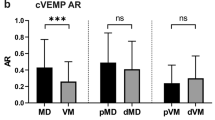Abstract
The objective was to investigate vestibular evoked myogenic potentials (VEMP) in benign paroxysmal positional vertigo (BPPV) and Meniere’s disease, and to determine if this type of testing is valuable for assessing the vestibular system. A prospective controlled clinical study was designed in a tertiary referral center setting. The 62 participants included 17 healthy controls and 45 other subjects selected from patients who presented with the complaint of vertigo (25 diagnosed with BPPV and 20 diagnosed with Meniere’s disease). The main outcome measures of VEMP were recorded in all subjects and findings in each patient group were compared with control findings. The VEMP for the 30 affected ears in the 25 BPPV patients revealed prolonged latencies in eight ears and decreased amplitude in one ear (nine abnormal ears; 30% of total). The recordings for the 20 affected ears in the Meniere’s disease patients revealed four ears with no response, six ears with prolonged latencies (ten abnormal ears; 50% of total). Only two (5.9%) of the 34 control ears had abnormal VEMP. The rate of VEMP abnormalities in the control ears was significantly lower than the corresponding rates in the affected BPPV ears and the affected Meniere’s ears that were studied (P=0.012 and P<0.001, respectively). The results suggest that testing of VEMP is a promising method for diagnosing and following patients with BPPV paroxysmal positional vertigo and Meniere’s disease. Further investigations with this method in other neurotologic pathologies might also be informative.



Similar content being viewed by others
References
AAO-HNS Committee on Hearing, Equilibrium (1995) Guidelines for the diagnosis and evaluation of therapy in Meniere’s disease. Otolaryngol Head Neck Surg 113:181–185
Baloh RW, Honrubia V (1990) Clinical neurophysiology of the vestibular system, 2nd edn. F.A. Davis, Philadelphia, PA
Baloh RW, Honrubia V, Jacobson K (1987) Benign positional vertigo: clinical and oculographic features in 240 cases. Neurology 37:371–378
Bickford RG, Jacobson JL, Cody DT (1964) Nature of average evoked potentials to sound and other stimuli in man. Ann NY Acad Sci 8:204–223
Cheng PW, Murofushi T (2001) The effects of plateau time on vestibular-evoked myogenic potentials triggered by tone bursts. Acta Otolaryngol 121:935–938
Colebatch JG, Day BL, Bronstein AM, Davies RA, Gresty MA, Luxon LM, Rothwell JC (1998) Vestibular hypersensitivity to clicks is characteristic of the Tullio phenomenon. J Neurosurg Psychiatry 65:670–678
Colebatch JG, Halmagyi GM (1992) Vestibular evoked potentials in human neck muscles before and after unilateral vestibular deafferentation. Neurology 42:1635–1636
Colebatch JG, Halmagyi GM, Skuse NF (1994) Myogenic potentials generated by a click-evoked vestibulocollic reflex. J Neurol Neurosurg Psychiatry 5:190–197
De Waele C, Huy PT, Diard JP, Freyss G, Vidal PP (1999) Saccular dysfunction in Meniere’s disease. Am J Otol 20:223–232
Geisler CD, Frishkopf LS, Rosenblith WA (1958) Extracranial responses to acoustic clicks in man. Science 128:1210–1211
Halmagyi GM, Colebatch JG, Curthoys IS (1994) New tests of vestibular function. Baillieres Clin Neurol 3:485–500
Heide G, Freitag S, Wollenberg I, Iro H Schimrigk K, Dillman U (1996) Click evoked myogenic potentials in the differential diagnosis of acute vertigo. J Neurol Neurosurg Psychiatry 66:787–790
Korres S, Balatsouras D, Kaberos A, Economou C, Kandiloros D, Ferekidis E (2002) Occurrence of semicircular canal involvement in benign paroxysmal positional vertigo. Otol Neurotol 23:926–932
Kushiro K, Zakir M, Ogawa Y, Sato H, Uchino Y (1999) Saccular and utricular inputs to sternocleidomastoid motor neurons of decerebrate cats. Exp Brain Res 126:410–416
Matsuzaki M, Murofushi T (2002) Click-evoked potentials on the neck of the guinea pig. Hear Res 165:152–155
Matsuzaki M, Murofushi T, Mizuno M (1999) Vestibular evoked myogenic potentials in acoustic tumor patients with normal auditory brainstem responses. Eur Arch Otorhinolaryngol 256:1–4
Murofushi T, Curthoys IS (1997) Physiological and anatomical study of the click-sensitive primary vestibular afferents in the guinea pig. Acta Otolaryngol (Stockh) 117:66–72
Murofushi T, Halmagyi GM, Yavor RA, Colebatch JG (1996) Absent vestibular evoked myogenic potentials in vestibular neurolabyrinthitis: an indicator of inferior vestibular nerve involvement. Arch Otolaryngol Head Neck Surg 122:845–848
Murofushi T, Matsuzaki M, Mizuno M (1998) Vestibular evoked myogenic potentials in patients with acoustic neuromas. Arch Otolaryngol Head Neck Surg 124:509–512
Murofushi T, Matsuzaki M, Takegoshi H (2001) Glycerol affects vestibular evoked myogenic potentials in Meniere’s disease. Auris Nasus Larynx 28:205–208
Murofushi T, Matsuzaki M, Wu CH (1999) Short tone burst-evoked myogenic potentials on the sternocleidomastoid muscle: are these potentials also of vestibular origin. Arch Otolaryngol Head Neck Surg 125:660–664
Murofushi T, Shimizu K, Takegoshi H, Cheng PW (2001) Diagnostic value of prolonged latencies in the vestibular evoked myogenic potential. Arch Otolaryngol Head Neck Surg 127:1069–1072
Ochi K, Ohashi T, Kinoshita H (2002) Acoustic tensor tympani response and vestibular-evoked myogenic potential. Laryngoscope 112:2225–2229
Parnes LS, McClure JA (1992) Free-floating endolymph particles: a new operative finding during posterior semicircular canal occlusion. Laryngoscope 102:988–992
Ushio M, Matsuzaki M, Takegoshi H, Murofushi T (2001) Click- and short tone burst-evoked myogenic potentials in cerebellopontine angle tumors. Acta Otolaryngol Suppl 545:133–135
Welling DB, Parnes LS, O’Brien B, Bakaletz LO, Brackmann DE, Hinojosa R (1997) Particulate matter in the posterior semicircular canal. Laryngoscope 107:90–94
Welgampola MS, Colebatch JG (2001) Characteristics of tone-burst evoked myogenic potentials in the sternocleidomastoid muscles. Otol Neurotol 22:796–802
Young Y, Huang T, Cheng P (2003) Assessing the stage of Meniere’s disease using vestibular evoked myogenic potentials. Arch Otolaryngol Head Neck Surg 129:815–818
Author information
Authors and Affiliations
Corresponding author
Rights and permissions
About this article
Cite this article
Akkuzu, G., Akkuzu, B. & Ozluoglu, L.N. Vestibular evoked myogenic potentials in benign paroxysmal positional vertigo and Meniere’s disease. Eur Arch Otorhinolaryngol 263, 510–517 (2006). https://doi.org/10.1007/s00405-005-0002-x
Received:
Revised:
Accepted:
Published:
Issue Date:
DOI: https://doi.org/10.1007/s00405-005-0002-x




